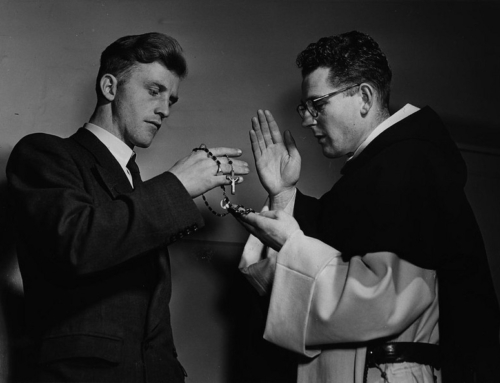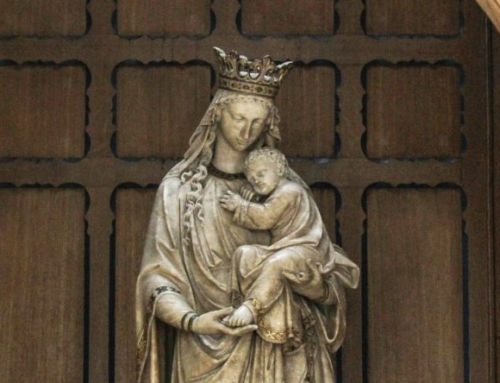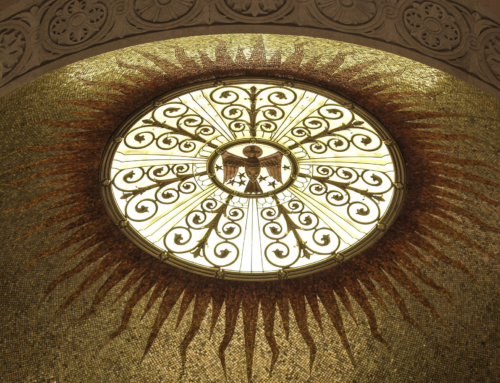Nan Bentzen Skille, Inside the Gate: Sigrid Undset’s Life at Bjerkebæk, Minneapolis: University of Minnesota, 2018.
G.K. Chesterton and Flannery O’Connor hold a similar spell over the somewhat-intellectually inclined American Catholic. At more than a few gatherings of Catholics, I have noticed that the mention of one of these names will lead, over the course of the next five minutes, to the gathering of a small crowd. Voices rise, excitedly throwing out words over the hubbub like “paradox” and “the grotesque” and “sacramental imagination.” Soon enough, someone suggests continuing the conversation over coffee or drinks, at which point the whole party moves off, each person deservedly delighted at having found others who know the joys of mixing fine prose and theological rumination.
If she does not already possess a comparable recognition, Sigrid Undset seems to be launching a campaign to join this club of eminent Catholic conversation starters. I even heard a middle-aged Dominican priest exclaim unabashedly, “Kristin Lavransdatter changed my life!” Something about the writings of this Norwegian convert causes an ever-broadening swathe of Catholics to find in her a friend, mentor, and guide—a way of seeing the world and of responding to it.
Inside the Gate: Sigrid Undset’s Life at Bjerkebæk, a newly translated biographical work by Nan Bentzen Skille, offers a glimpse into the life of this influential author and her home. Drawing upon a variety of sources (housekeeping records, letters, and photographs) that previously have not been published, Skille focuses her work on Undset’s life after 1919, when the author separated from her fickle husband, the painter Anders Svarstad, and moved away from Norway’s capital to establish a home in Lillehammer, a small town some hours north of Oslo. This home would remain hers until the end of her life. In her book, Skille contemplates Undset through the lens of this home. Her attempt to “‘read’ the values and attitudes expressed in the artist’s home” (6) shares a privileged insight into the familial, historical, and religious setting in which Undset wrote some of the most profoundly Catholic novels of the twentieth century. And it gives us at least some hints about why Undset’s writings continue to offer respite and encouragement for the twenty-first century reader.
Undset’s longest works—Kristin Lavransdatter and Master of Hestviken—were published when she lived at Bjerkebæk. She arranged her home, as most homeowners, in such a way as to express her commitments and lifestyle and interests—commitments that are evident in her novels as well. She wanted visual connections to Norway’s history. She needed peace and quiet to work. She needed room for her boisterous boys. To meet these demands, she purchased an already existing historic timber house and had it dismantled, moved, and attached to the building originally on the property. Before the addition, she had complained to a friend, “people have been treating my house like a train station” (59). Her relief is quite evident when the work neared completion: “This week I move in. . . . And then—I’ll have peace, with only my boys close by—and I won’t have to hear and see and smell strangers close by around the clock” (63). After the building was done, she established expectations such that “no children dared run into Undset’s rooms uninvited if they had scraped their knees” (64). As an author committed to the task of writing, she guarded her quiet closely. In reading her works, we encounter a world that emerged from diligent research and the silence of creative contemplation.
Around the same time that the expansion project reached completion, Undset became Catholic. While Skille does not give the fullest account of Undset’s conversion, we learn about her long-standing, at-least-superficial interest in the faith (she wrote a somewhat scandalous story about a nun and a priest as a fourteen-year-old), as well as some of the responses she received when her conversion became public—a conversion that some Norwegians regarded as “near treason” (74). Soon priests would come to say Mass in the main room of the house a couple times a month. In 1928, Undset became a Dominican tertiary, taking the religious name “Olave” after Norway’s patron, St. Olaf. She became an active member at a parish in a neighboring town, grew close to Dominican nuns in Oslo, and did a lot to make Catholicism a live option for Norwegian Lutherans.
Besides Undset’s need for quiet, her family had other special requirements. Along with her two healthy sons, Anders and Hans, she had a daughter, Mosse, who suffered from severe developmental disabilities. She fell into frightening epileptic fits and never acquired mature verbal or cognitive faculties, living in a world mostly her own.
The hiring of help became necessary. While some of these maids spent only a short season at Bjerkebæk, the extent to which others became central figures of the household is evident in the case of Mathea Mortenstuen. She provided twenty-four-hour care to the ever-ailing Mosse, and she kept the house in order, shopped, cooked, and, in general, functioned as a second-in-command to Undset. Their friendship led Mathea to the Catholic Church in 1928. This closeness notwithstanding, it is clear that Undset managed her house with a clear sense of boundaries: As Skille notes, “In its heyday, Bjerkebæk was run more like a patrician household from earlier days than an ordinary home in a small town, and Sigrid Undset took her role as Mistress very seriously and made a point of maintaining her dignity” (158–9). After the libertinism of her younger years, Undset knew the necessity of order and cultivated it in her home as best she could.
But in a house with children, order can only be approximated. Undset’s two sons caused their mother many joys and difficulties. Without her husband around, the responsibility to discipline fell on Undset’s shoulders alone. Anders would test his mother:
At home he tried out his talents as boss, a role that he evidently thought it was his duty to assume, as the eldest male. His mother allowed him to test his wings at it, but occasionally she had to intervene if he went too far. For instance, he once promised 10 øre to little Brit, the daughter of his half-sister Gunhild, if she would lick the soles of his shoes clean, even though there was horse manure on them. (115)
Anders never became a Catholic and died defending Norway against Nazi invaders. His younger brother, Hans, had a creative, sensitive, and ostentatious personality, and had difficulties settling into new schools and social situations. He relied on Undset for financial support for much of his life.
Despite the obstacles to family peace, Undset managed to establish a mode of life that was at once domestic and formal, comfortable and in certain ways a bit austere. Undoubtedly, her home and children suffered from the absence of a faithful father. Undset would not deny this. Her recognition of the deep, deep wounds of sin did not allow her to imagine away the brokenness of her family. But this experience of brokenness gave depth to her art: While the families in Undset’s novels transcend the limits of her own biography, her profundity of insight into the joys and sorrows of familial relationships obviously drew inspiration from her own life.
In all these difficulties, if Undset could be willful and impatient, she could also be extraordinarily generous. Once she became successful, she would tell her sister and friends, “Send me the bill” (55). Most dramatic, however, was the decision she made upon receiving the Nobel Prize for literature in 1928. She donated all the attendant prize money to establish charitable foundations.
As the Nazis rose to power in Germany, Undset’s position as a leading writer in Norway gave her a voice of authority to denounce the inhumanity of their regime. This made her a target for the Nazis when they invaded Norway in April 1940. She fled through Russia and spent almost five years as an exile in the United States, where she wrote and spoke on behalf of the Allies. Finally, in May 1945, she could return home, where only four years later, she died at the age of sixty-seven.
The strength of Inside the Gate comes from the Skille’s willingness to give attention to the smallest details of Undset’s homelife. The book struggles, however, in discriminating between the more and less important “values and attitudes” (6) expressed in these details. We find Undset’s love of interior decorating treated in a similar way as her conversion to Catholicism, almost as if these were two equally relevant elements of her life. Thus, at times Skille’s approach unfortunately obscures where Undset placed her priorities. For example, Undset’s home was important to her, but the values expressed by her house and lifestyle found their fullest expression when she was forced to abandon that house to the misuse of Nazis—while exiled in America, she did not “seem to have lost any sleep over the uncertain fate of Bjerkebæk” (224). Skille’s presentation makes it difficult to see why Undset would react with such detachment to the desecration of the home she loved. But when we consider that Undset’s faith taught her that any sense of domestic contentment enjoyed here on earth was but a gift and a promise of another, far truer, home, her reaction becomes intelligible.
Still, even though Skille undersells the far-reaching implications of the faith that gave the author’s later years such a visible energy and unity, Inside the Gate merits a read as it makes available many vibrant stories, pictures, and letters from Undset’s life. From these details, in a manner more pointillist than photographic, the full story of Undset’s life, of her “values and attitudes,” begins to emerge.
✠
Download a PDF of this review here.



